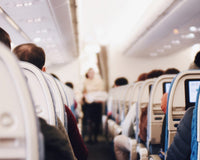Thanks to this article, discover which items are forbidden in your cabin baggage. Indeed, some items are allowed on board, others are only allowed in checked luggage, and some are simply forbidden.
Baage offers you an overview to help you understand. In short: what products are allowed in a carry-on bag?
It is important to comply with these strict requirements, as cabin luggage is subject to rigorous control by airport personnel or authorities. Indeed, your luggage will be subject to an X-ray check and may be searched if necessary. However, you should know that a verbal obligation is required before security personnel can open your hand luggage.
Liquids with a capacity of more than 100 ml
Each bottle of liquid must not exceed 100 ml and must be placed in a transparent plastic bag that must not exceed 20 cm x 20 cm. Thus, your shower gel must be transferred into a specific container adapted to the constraints of the aircraft cabin.
Although a simple transparent plastic bag, such as a freezer bag, may be suitable, there are ready-to-use travel kits. These are clear plastic zippered kits with empty containers and receptacles that meet current standards.
So you can fill them with your liquids, creams and gels without fear of them being confiscated by the authorities. In addition, some brands offer pre-filled kits of their products and cosmetics in travel size.
The solution?
Underseat Luggage 46cm CONGO
It can also be a good idea to choose solid soaps, shampoos and toothpastes; this will avoid the restriction of liquids while saving space in your luggage.
Some exceptions
Baby food: Baby products are not affected by these rules. This is also the case for dietary foods (gluten-free, sugar-free, etc.).
Medicines: if you need to take medicines and other creams with you to treat yourself, you should know that these items are not subject to the liquid restriction regulations. However, you must have a medical prescription.
Weapons and other sharp objects
All sharp objects of any kind are prohibited in the cabin. Knives, razors, scissors, blades, cutters and other dangerous objects cannot be carried in the cabin (either on your person or in a bag). You will have to place them in the hold.
It is also important to know that all firearms as well as ammunition and cartridges for hunting and sporting weapons are also prohibited in the cabin.
Objects prohibited in the cabin as well as in the hold
Flammable and potentially dangerous products are forbidden in the cabin as well as in the hold. This is the case for
- lighters, matches and other small fuels,
- Batteries with electrolyte,
- Printer cartridges,
- Lithium batteries with a capacity greater than 160 Wh,
- Fireworks, firecrackers, flares, fire starter bricks, tear gas,
- Dummy guns
- Gas bottles and oxygen or nitrox diving bottles, whatever they are.
- Industrial lacquers, varnishes or paints
- Chemical products called exceptional (included in this category are fertilizers, pesticides and weed killers)
- Cleaning liquids (e.g. bleach, chlorine, fuels, solvents, acetone and thinners...)
- Old generation mercury thermometers
Specificities linked to certain airlines
The information we provide is given as an indication. Indeed, some rules may vary from one company to another; for example, some airlines allow you to carry a lighter as long as it remains in one of your pockets in a plastic bag.
What are the reasons for these restrictions?
These strict regulations were put in place by IATA (International Air Transport Association) to ensure the safety of the flight crew and passengers.
You can find out more about hand luggage regulations by airline (such as Air France, Ryanair or Easyjet). Why not take a look at our carry-on luggage selection?












